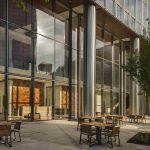How is Engineering Integrated into Architecture?
Walking through the door, you shiver and brush the snow off your coat. You can feel the warmth on your cheeks and give a sigh of relief. Looking around, you take in the beautiful décor of the lobby, three stories high…and no sign of a heater. So where is the warm air coming from?
Engineers are masters of disguise, perhaps some of the greatest magicians on Earth. They have the ability to hide complex systems, such as mechanical and electrical systems, within a building’s architecture. This can be extremely difficult, especially when dealing with a building with unique architectural features or a high-rise, and requires its own level of creativity and innovation. As Steph Guy, P.E., LEED AP, an associate principal at Alvine Engineering summarizes, “True integration of engineering into architecture can have a beautiful impact – it is truly a work of art.”
Take a peek behind the curtain of one of downtown Chicago’s most prominent jewels: River Point.
How does the exterior integrate engineering into architecture?
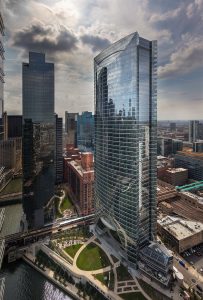 River Point is a 52-story, LEED Platinum office tower in Chicago’s West Loop on the edge of the Chicago River. The 1.5-acre plaza and river walk is one of River Point’s biggest illusions. On top, it is the largest riverfront park in the city of Chicago; below, are active rail lines. Walking along the river, visitors are not bothered by the rail lines or the monotony of a plain wall thanks to the strategically-spaced porticoes. What the average person does not realize strolling by, is that those same porticoes that break up the wall, also provide adequate ventilation for the rail lines tucked behind.
River Point is a 52-story, LEED Platinum office tower in Chicago’s West Loop on the edge of the Chicago River. The 1.5-acre plaza and river walk is one of River Point’s biggest illusions. On top, it is the largest riverfront park in the city of Chicago; below, are active rail lines. Walking along the river, visitors are not bothered by the rail lines or the monotony of a plain wall thanks to the strategically-spaced porticoes. What the average person does not realize strolling by, is that those same porticoes that break up the wall, also provide adequate ventilation for the rail lines tucked behind.
Looking up at the tower itself, admirers notice its clean look and the way the sun gleams off the many windows. The curved design allows daylight to stream into the building. What these admirers don’t see is the six-cell cooling tower located at the top of the building and fully hidden by the extended and sloped façade. Instead, their eyes move to the arched and concaved features that look almost like a “smile” and “frown.” Beautiful to look at, they also hide a critical building function: snow and ice mitigation.
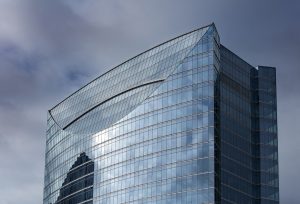
Being a high-rise in a city that averages 36 inches of snowfall a year, it was essential for River Point to be able to effectively manage snow and ice. Designed for the top angled portion of the exterior façade, the snow and ice mitigation system is meant to alleviate any icicles from falling on pedestrians below. While this is an important safety feature, it’s not a particularly attractive feature, which is why the piping and gutter systems were completely hidden within the “smile” and “frown.”
The archway at the base of the building is likewise integrated with the mechanical and plumbing systems of the tower as the entire length of the arch serves as a gutter for the vertical façade of the building. It also protects the entryway just below without any impacts on the overall aesthetic. Careful not to be wasteful, all runoff from the gutters is then piped to a cistern where the water is filtered and UV-sterilized before being used in irrigation for the 1.5-acre park.
What about inside the tower?
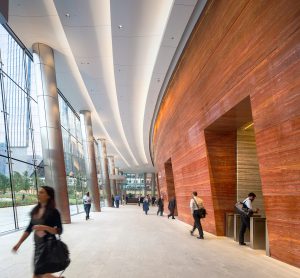
Walking under the arch and through the front doors, visitors are greeted by a 3-story lobby filled with grand architecture and décor. What they do not see, are the mechanical systems, which were integrated into the architecture with zero influence on the aesthetics of the space. All of the required ductwork is concealed above the ceiling and within the canted stone wall. The supply diffusers and a return air reveal are well hidden in the ceiling so they are not visible to the untrained eye.
One of the most stunning features of the lobby, the 3-story curtain wall, also presented a difficult challenge. With River Point being located in Chicago, heat at the exterior perimeter was a must; however, installing objects or systems that would cover them up would defeat the purpose. Therefore, the mechanical design team coordinated closely to conceal the hydronic fin tube within the sill of the curtain wall.
The air handling units serving the lobby not only heat and cool the space, but also have an important role to play in the pressurization of the building. “Stack effect” occurs in a building when warm air is moved upward and, if the air inside is warmer than the air outside, it is forced out the top of the building. Pressure at the base of the building is then reduced, forcing cooler air from outside into the building through the lobby or base of the building to replace the air that has been forced out the top. This can cause the temperature to vary throughout different parts of the building and impact energy efficiency. To combat stack effect in the River Point tower, the air handling units in the lobby are designed to utilize a large amount of outside air when necessary.
Where is engineering integrated into office architecture?
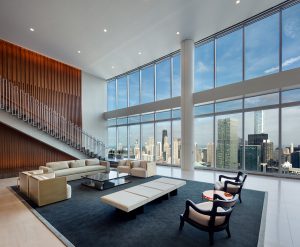
Even areas such as the office space include engineering solutions that are not obvious, but allow the space to reach its full potential. In the office space, the structural engineer achieved efficient, column-free floor plates even with floor-to-ceiling glass at the building exterior. Meanwhile, the mechanical design on each floor included a medium pressure duct loop to serve fan-powered terminal boxes on each level. Both of these features allow each office area to be as flexible as possible to suit the needs of various tenants.
Tenants also enjoy options with variable ceiling heights. This is made possible because the duct loop was intricately integrated with the structural design, including penetrating the W33 girders (33-inch deep beams) at each end of the building so the duct could be held tight to structure, ultimately maximizing the available ceiling heights. Again, the average person would notice the high ceilings and, perhaps subconsciously, the comfortable air temperature, rather than the mechanical systems.
What is the secret to integrating engineering into architecture?
“In order to achieve this high level of design and integration,” Steph Guy reveals, “it really takes the full design team [architects, engineers, and owners] collaborating together to make it happen.” The office space was far from the only area where professionals from all disciplines needed to work together. From the structural engineer to the acoustician, everyone collaborated to ensure that each design fit within the others.
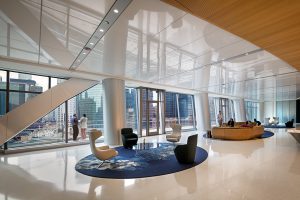
The air handling units serving River Point showcase this perfectly. “To meet certain City of Chicago code requirements, this building was designed with eight very large air handling units,” Guy notes. This means that all members of the design team must accommodate very large equipment and system parts within their designs. Some pieces, such as duct risers, flow between floors, requiring careful coordination with the architect to ensure they do not negatively affect the floor plan. For further perspective on the scale the team worked with, Guy explains, “These [duct risers] are not small ducts; they are ducts that are ten foot wide and five foot deep. So the structural engineer needs to be aware of the floor penetrations associated with these so proper framing can be coordinated.” With so many moving parts, successful integration of engineering into architecture truly does appear to be magic.
Where can I learn more?
Visit the River Point website to learn more about its community, amenities, and availabilities.
Read the article “How Does Engineering Encourage Sustainability?” to learn more about the LEED certification system.
Photography credit: ©David Sundberg/Esto.




